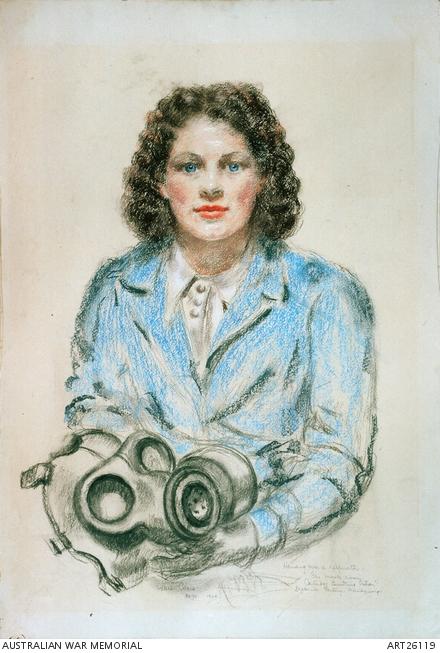Ruby Wilks

Sybil Craig, Handing over a respirator (Ruby Wilks) (1945, pastel, 81.3 x 56.5 cm, AWM ART 26119)
Ruby Wilks left school when she was about 15 years old and went to work at Myers as a junior sales assistant. When the war started, she applied for a “man's job”, and won the position of “elevator girl” at a large Melbourne department store. Ruby was also a professional dancer and taught part-time at a dancing school.
In 1941 Ruby decided to join her friend working at the Maribyrnong Munitions Factory. Her day started at a quarter to five in the morning, when she caught a train to the city. Work started at half-past six or a quarter to seven, and the women would often have to work late, making a nine- or ten‑hour workday. The factory itself had an iron roof and was uninsulated, making it cold in winter and hot in summer.
Safety and confidentiality were important at the factory. The women who worked with the high-explosives worked in “clean and dry areas” and were required to wear special clothes. The danger was real, and fatal explosions occurred during the war years. Ruby worked in another area of the factory known as the Munitions Supply Laboratory. This was a safer area to work, but there were still accidents. Ruby’s job was to inspect the component parts that made up the respirators. She also operated a large machine with a sharp knife to cut eye holes out of the respirators.
When the war ended Ruby told her mother that she intended to do nothing for four months except “sleep, sleep, sleep and do exactly what she wanted”. After this, she went back to teach dancing. She later married and had a son.
Activities
- Women made a significant contribution to Australia’s war effort during the Second World War. How might they have been able to offer assistance? Why were so many women needed for different roles?
- The women who worked in munitions factories often did so in crowded little bays. This painting by Sybil Craig depicts the close proximity of the women’s workspace. How do you think they might have felt about working in these spaces for 9–10 hours a day?

Sybil Craig, Soldering bay (Cartridge Bundling Section, Commonwealth Explosives Factory, Maribyrnong) (1945, oil on canvas on plywood, 42 x 45.4 cm, AWM ART 22137)
- The jobs women undertook in munitions factories could be quite dangerous. Why do you think women were so eager to sign up and “do their bit” despite the danger?
- How did their contribution to the Second World War change things for women in Australia?